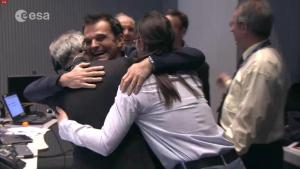Blog
Song for a Comet
13 November 2014
Yesterday Philae landed on a comet. It was the first successful soft landing on a comet, though it likely won’t be the last. This is something everyone should be excited about. With all the things to complain about in the world, here is a chance to celebrate a huge achievement of human ingenuity. We have a robotic probe on the surface of a comet.
 ESA
ESAThere’s been a lot in the news about how this is the culmination of a 10 year mission, but that’s only the time since Rosetta’s launch. The idea for a comet lander dates at least as far back as the 1980s, when the Giotto spacecraft made a flyby of Halley’s comet. This led to plans for a mission to land on a comet and return with cometary material, but that was later scaled back to just a lander for budgetary reasons.
 Cumbrian Sky
Cumbrian SkyDesign and construction of the Rosetta and Philae spacecraft date back to the 1990s, with major construction beginning around the turn of the century. It was originally scheduled to land on a comet known as 46P/Wirtanen, but delays led to the change to 67P/Churyumov–Gerasimenko.
The reason comets are such an important target is because they contain the most primal materials of the solar system. Unlike most of the bodies in the inner solar system, which have been mixed and bombarded over the ages, comets have an origin in the outer edges of the solar system known as the Oort cloud.
Philae has a planned mission of about 6 weeks, so there is going to be a lot of data gathered, and over time results will start being published. But we’ve already learned a few surprising things. One is that the comet itself sings. Not in the traditional way we think of, but rather in electromagnetic waves. The comet’s weak magnetic field interacts with the coma and solar wind to create a warbling effect. You can hear the sound in the video above, where it’s been sped up from its actual millihertz range.
So we’ve sent a spacecraft into space, put it in orbit near a comet, landed on it with a smaller probe, and listened to the comet’s song. What an amazingly human thing to do.